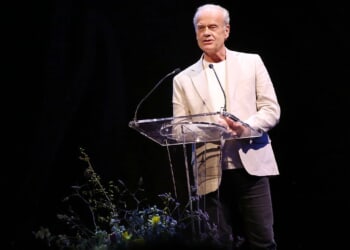China and Russia will publicly display their deep ties during the annual Victory Day Parade in Moscow, signaling a strong bond that the Biden administration’s foreign policy helped cement.
Chinese President Xi Jinping will be joining Russian President Vladimir Putin from Wednesday to Saturday for the parade marking 80 years since the end of World War II, symbolically reaffirming the two nations’ close connection. Biden’s sweeping sanctions against the two nations and ineffective diplomatic outreach during his tenure as commander-in-chief helped drive the two countries into each others’ arms by simultaneously attempting to isolate both from key Western systems and markets.
“To draw, to push together two nuclear powers, Russia and China, it’s really a blunder of the highest order … The Russians had a million army troops built up on the Chinese border for a while, so to see them come together like this to me is just shocking,” Heritage Foundation senior fellow Michael Pillsbury told Fox & Friends in May 2024. “It’s one of the biggest blunders we’ll see in my lifetime.” (RELATED: Scott Bessent Says Trump Admin Has ‘Not Engaged In Negotiations’ With China ‘Yet’)

In this pool photograph distributed by the Russian state agency Sputnik, Russia’s President Vladimir Putin and China’s President Xi Jinping attend an official welcoming ceremony in front of the Great Hall of the People in Tiananmen Square in Beijing on May 16, 2024. (Photo by SERGEI BOBYLYOV/POOL/AFP via Getty Images)
The Biden administration warned China on Feb. 3, 2022 that if it aided Russia in avoiding sanctions for its predations against Ukraine, there would be consequences. Just a day later, China and Russia responded by announcing a “no-limits” partnership which included closer political, economic and military cooperation. By the end of February 2022, Russian tanks had rolled into Ukraine.
Despite the Biden administration’s warnings, China continued to supply key technologies to Russia, such as computer chips, while stopping short of selling weapons outright. Chinese citizens were even spotted on the front lines of the Ukraine war, with Kiev announcing in April they had captured two Chinese nationals with identifying papers.
Instead of changing course on sanctions, Biden then further used sanctions against Russia in June 2024 in order to stem the flow of money and goods that can fuel the country’s war against Ukraine. In turn, Russia suspended trades on the U.S. dollar.
Moreover, Biden’s sanctions against China appear to have backfired, driving up imports and exports from Russia to China from roughly $11 billion in April 2021 to over $19 billion as of April 2024, according to data from China’s General Administration of Customs. China also became a major buyer of sanctioned and discounted Russian oil, with Russia becoming China’s top oil supplier by the end of 2023.
Iran, another partner in the anti-Western alliance, also emerged as a leading oil supplier for China during the Biden presidency, in large part because the Biden administration did not strongly enforce existing sanctions against the Iranian energy sector. North Korea, another member of the informal alliance against the West, also chipped in by supplying Russia with men and weapons to fight in Ukraine.
The BRICS alliance, an informal international partnership driven primarily by Brazil, Russia, India China, and South Africa, also rose as a key engine driving Russian and Chinese influence abroad during the Biden era.
BRICS has made steady progress in shifting international payments away from the U.S. dollar, which has enjoyed financial hegemony for decades. Russian Foreign Minister Sergey Lavrov announced April 29 that 65% of internal payments between BRICS nations were done with local currencies instead of the dollar, and some analysts worry that unchecked growth of BRICS could eventually threaten the dollar’s status as the world’s reserve currency.
President Donald Trump is working to drive a wedge between the two powers, not unlike former President Richard Nixon’s push to open up China and coax the country away from what was then the Soviet Union.
“This would never happen under Trump,” Pillsbury told Fox News. “This is a big blunder, I think, by the Biden people to drive Russia and China together. This was one of Trump’s goals, never to allow this to happen.”
All content created by the Daily Caller News Foundation, an independent and nonpartisan newswire service, is available without charge to any legitimate news publisher that can provide a large audience. All republished articles must include our logo, our reporter’s byline and their DCNF affiliation. For any questions about our guidelines or partnering with us, please contact licensing@dailycallernewsfoundation.org.




![‘It’s a Recipe for a Hundred Years of National Dominance’: Stephen Miller [WATCH]](https://www.right2024.com/wp-content/uploads/2025/05/Stephen-Miller-Completely-Obliterates-CNN-Host-Over-Her-Illegal-Immigration-350x250.jpg)
![Trump Posts Hilarious Pope Meme, Leftists Immediately Melt Down [WATCH]](https://www.right2024.com/wp-content/uploads/2025/05/Trump-Posts-Hilarious-Pope-Meme-Leftists-Immediately-Melt-Down-WATCH-350x250.jpg)



![Mother Breaks Silence After Three Daughters Killed During Father’s Custody Visit, Memorial Held [WATCH]](https://www.right2024.com/wp-content/uploads/2025/06/Mother-Breaks-Silence-After-Three-Daughters-Killed-During-Fathers-Custody-350x250.jpg)

![Pentagon Begins Booting Trans Troops After Supreme Court Greenlights Ban [WATCH]](https://www.right2024.com/wp-content/uploads/2025/05/Pentagon-Begins-Booting-Trans-Troops-After-Supreme-Court-Greenlights-Ban-350x250.jpg)





